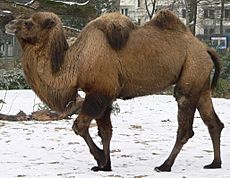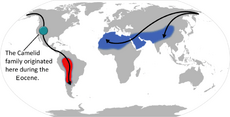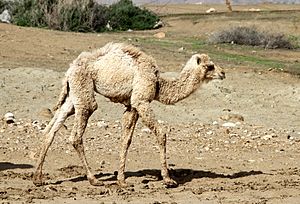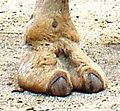Camelid facts for kids
Quick facts for kids Camelid |
|
|---|---|
 |
|
| A Bactrian Camel walking in the snow | |
| Scientific classification | |
| Kingdom: | |
| Phylum: | |
| Class: | |
| Order: | |
| Suborder: |
Tylopoda
|
| Family: |
Camelidae
Gray, 1821
|
| Genera | |
|
Lama |
|
 |
|
| Map of the world showing distribution of camelids. Solid black lines indicate possible migration routes. | |
Camelids are a group of amazing mammals. They are known for their long necks and legs. This group includes animals like camels, llamas, and alpacas. There are six different types, or species, of camelids alive today. They all belong to the animal family called Camelidae.
Contents
Types of Camelids: A Family Tree
Camelids are divided into different groups, like branches on a family tree.
Camelids of Asia and Africa
These camelids are found in parts of Asia and Africa. They belong to the group called Camelus.
- Dromedary (Camelus dromedarius): This camel has one hump.
- Bactrian Camel (Camelus bactrianus): This camel has two humps.
Camelids of South America
These camelids live in South America. They are split into two main groups: Lama and Vicugna.
- Llama (Lama glama): A large, strong animal often used for carrying things.
- Guanaco (Lama guanicoe): A wild camelid, similar to a llama.
- Vicuña (Vicugna vicugna): A smaller, wild camelid known for its very soft wool.
- Alpaca (Vicugna pacos): Bred for its soft wool, similar to a vicuña.
What is a Cama?
Sometimes, humans create a special camelid called a Cama. A Cama is a hybrid animal. This means it has parents from two different species. A Cama is born when a female Llama and a male Dromedary Camel have a baby. This usually happens through a process called artificial insemination. This is when the male's sperm is carefully put into the female by humans. You won't find Camas living in the wild.
Where Camelids Live: Their Habitat
Camelids live in different parts of the world.
- The two Camelus species (Dromedary and Bactrian camels) originally lived in northern Africa and parts of Asia.
- The four South American camelids (Llama, Guanaco, Vicuña, and Alpaca) live in South America. They are often found in the mountains.
Camelids and Humans: A Long History
Humans have worked with camelids for about 5,000 years. This is called domestication.
- Transportation: Camels were very important for travel and carrying goods, especially in deserts. They were like the trucks of ancient times!
- Resources: People also kept camelids for their wool, meat, and milk.
- Culture: The llama and alpaca were very important to ancient South American cultures, like the Inca. They helped these civilizations thrive in tough mountain environments.
Images for kids
-
A dromedary camel (C. dromedarius) in the Australian outback.
-
A South American vicuña (Vicugna vicugna).
See also
 In Spanish: Camélidos para niños
In Spanish: Camélidos para niños





